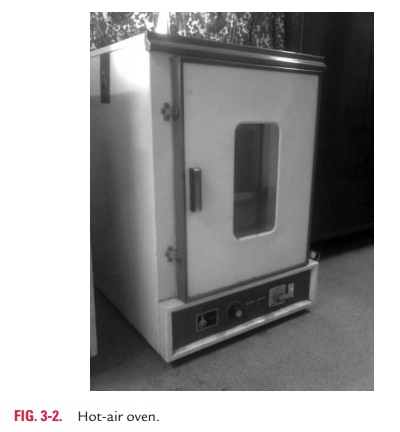Chapter: Microbiology and Immunology: Sterilizationand Disinfection
Sterilization by dry heat
Sterilization by dry heat
Sterilization by dry heat makes use of air with a low mois-ture content that has been heated by a flame or electric heating coil. In practice, the temperature of dry heat ranges from 160°C to several thousand degrees Celsius. The dry heat kills microorganisms by protein denaturation, oxidative damage, and the toxic effect of increased level of electrolytes. Dry heat is not as versatile or as widely used as moist heat, but it has several important sterilization applications. The temperature and time employed in dry heat vary according to the particular method, but in general they are greater than with moist heat. Sterilization by dry heat includes sterilization by (a) flaming, (b) incineration , and (c) hot air oven:
Flaming: Sterilization of inoculating loop or wire, the tipof forceps, searing spatulas, etc., is carried out by holding them in the flame of the Bunsen burner till they become red hot. Glass slides, scalpels, and mouths of culture tubes are sterilized by passing them through the Bunsen flame without allowing them to become red hot.
Incineration: Incineration is an excellent method forsafely destroying infective materials by burning them to ashes. It has many uses:
Incinerators are used to carry out this process and are regularly employed in hospitals and research labs to destroy hospital and laboratory wastes.
The method is used for complete destruction and dis-posal of infectious material, such as syringes, needles, culture material, dressings, bandages, bedding, animal carcasses, and pathology samples.
This method is fast and effective for most hospital wastes, but not for metals and heat-resistant glass materials.
Hot-air oven: The hot-air oven provides another means ofdry heat sterilization and is the most widely used method. The hot-air oven is electrically heated and is fitted with a fan to ensure adequate and even distribution of hot air in the chamber. It is also fitted with a thermostat that ensures circulation of hot air of desired temperature in the chamber. Heated, circulated air transfers its heat to the materials inside the chamber. While sterilizing by hot-air oven, it should be ensured that the oven is not overloaded. The materials should be dry and arranged in a manner which allows free circulation of air inside the chamber. It is essential to fit the test tubes, flasks, etc., with cotton plugs and to wrap Petri dishes and pipettes in a paper. Steriliza-tion by hot-air oven requires exposure to 160–180°C for 2 hours and 30 minutes, which ensures thorough heating of the objects and destruction of spores (Fig. 3-2).

Thermocouples, chemical indicators, and bacteriological spores of Bacillus subtilis are used as sterilization controls to determine the efficacy of sterilization by hot-air oven.
Related Topics